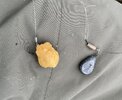Hi Ben, I'm no expert but I'll outline how it's worked for me, or at least my interpretation of it.
I've sort of had two approaches to it. The first one has been fishing quite close in, generally where there is little flow, but perhaps on the edge of flow, a slack or eddy. In this case I wouldn't normally be much more than a rod length out and would just be using enough split shot to hold bottom.
The other way has been fishing out in to the river although I have typically only done this on smaller rivers (the Dove being where I enjoyed it most). In this case I would be fishing in much the same way I would with a light bomb or feeder, fishing the edge of a crease. In this case I make sure I am slightly sitting upstream of where I want to fish, using a bow in the line and just enough split shot to hold bottom. I will envisage where I want the bait to settle and cast/ pay out line accordingly. If the bait is instantly swinging in to the near margin then it needs more weight or more of a bow. There comes a point where more bow isn't practical. Some swims just don't lend themselves to the method.
Using the right strength quiver tip helps as well, too much weight on too light a quiver will result in too much of bend (hindering bite detection/ increasing resistance), where as too little weight on too heavy a quiver will increase the chance of the bait dislodging as the tip fails to absorb the pressure.
In short I've found it a combination of getting the right weight, quiver tip and amount of bow in the line. Depending on where you sit and where you are trying to fish will also affect how it settles (or doesn't), I think fishing downstream at about 45degrees has worked for me. Line thickness also makes a difference, thicker line will be pulled out place more easily and require more weight.
That was quite waffly, I am sure someone else will be more concise but some points to think about anyway.

